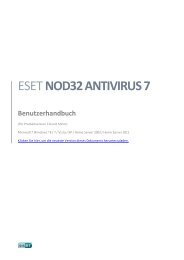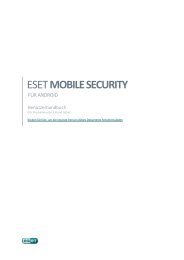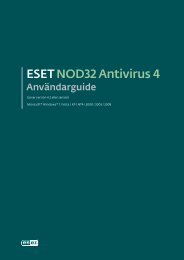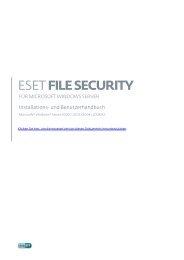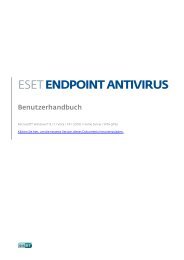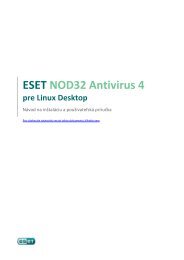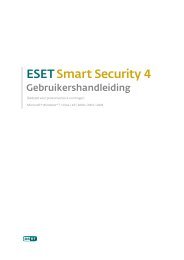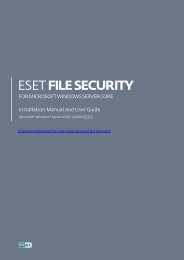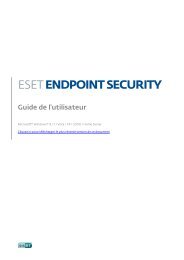ESET File Security Installation Manual and User Guide
ESET File Security Installation Manual and User Guide
ESET File Security Installation Manual and User Guide
Create successful ePaper yourself
Turn your PDF publications into a flip-book with our unique Google optimized e-Paper software.
6. Integration with <strong>File</strong> System services<br />
This chapter describes the On-dem<strong>and</strong> <strong>and</strong> On-access scanner configuration which will provide the most effective protection<br />
from virus <strong>and</strong> worm file system infections. <strong>ESET</strong> <strong>File</strong> <strong>Security</strong>’s scanning power is derived from the On-dem<strong>and</strong> scanner<br />
comm<strong>and</strong> ‘esets_scan’ <strong>and</strong> the On-access scanner comm<strong>and</strong> ‘esets_dac’. The Linux version of <strong>ESET</strong> <strong>File</strong> <strong>Security</strong> offers an<br />
additional On-access scanner technique which uses the preloaded library module libesets_pac.so. All of these comm<strong>and</strong>s are<br />
described in the following sections.<br />
6.1 On-dem<strong>and</strong> scanner<br />
The On-dem<strong>and</strong> scanner can be started by a privileged user (usually a system administrator) through the comm<strong>and</strong> line<br />
interface, web interface or by the operating system’s automatic scheduling tool (e.g., cron). The term On-dem<strong>and</strong> refers to file<br />
system objects which are scanned on user or system dem<strong>and</strong>.<br />
The On-dem<strong>and</strong> scanner does not require special configuration in order to run. After the <strong>ESET</strong>S package has been properly<br />
installed <strong>and</strong> a valid license has been moved to the license keys directory (@ETCDIR@/license), the On-dem<strong>and</strong> scanner can be<br />
run immediately using the comm<strong>and</strong> line interface or the Scheduler tool. To run the On-dem<strong>and</strong> scanner from the comm<strong>and</strong> line,<br />
use the following syntax:<br />
@SBINDIR@/esets_scan [option(s)] FILES<br />
where FILES is a list of directories <strong>and</strong>/or files to be scanned.<br />
Multiple comm<strong>and</strong> line options are available using <strong>ESET</strong>S On-dem<strong>and</strong> scanner. To see the full list of options, please see the<br />
esets_scan(8) man page.<br />
6.2 On-access scanner using preload LIBC library<br />
The On-access scanner is invoked by user(s) access <strong>and</strong>/or operating system access to file system objects. This also explains the<br />
term On-access; the scanner is triggered on any attempt to access a selected file system object.<br />
In the following sections, we will also describe the integration of the On-access scanner powered by Dazuko with Linux/BSD file<br />
system services. Using Dazuko may not be feasible in all situations, including system administrators who maintain critical<br />
systems where:<br />
the source code <strong>and</strong>/or configuration files related to the running kernel are not available,<br />
the kernel is more monolithic than modular,<br />
the Dazuko module simply does not support the given OS.<br />
In any of these cases, the On-access scanning technique based on the preload LIBC library should be used. See the following<br />
topics in this section for detailed information. Please note that this section is relevant only for Linux OS users <strong>and</strong> contains<br />
information regarding the operation, installation <strong>and</strong> configuration of the On-access scanner using the preload library<br />
‘libesets_pac.so’.<br />
6.2.1 Operation principle<br />
The On-access scanner libesets_pac.so (<strong>ESET</strong>S Preload library based file Access Controller) is a shared objects library which is<br />
activated at system start up. This library is used for LIBC calls by file system servers such as FTP server, Samba server etc. Every<br />
file system object is scanned based on customizable file access event types. The following event types are supported by the<br />
current version:<br />
Open events<br />
This file access type is activated if the word ‘open’ is present in the ‘event_mask’ parameter in the esest.cfg file ([pac] section).<br />
Create (close) events<br />
This file access type is activated if the word ‘create’ is present in the ‘event_mask’ parameter in the esets.cfg file ([pac] section). In<br />
this case, all file descriptor <strong>and</strong> FILE stream create/close functions of the LIBC are intercepted.<br />
Exec events<br />
This file access type is activated if the word ‘exec’ is present in the ‘event_mask’ parameter in the esets.cfg ([pac] section). In this<br />
case, all exec functions of the LIBC are intercepted.<br />
All opened, closed <strong>and</strong> executed files are scanned by the <strong>ESET</strong>S daemon for viruses. Based on the result of such scans, access to<br />
given files is denied or allowed.<br />
11



